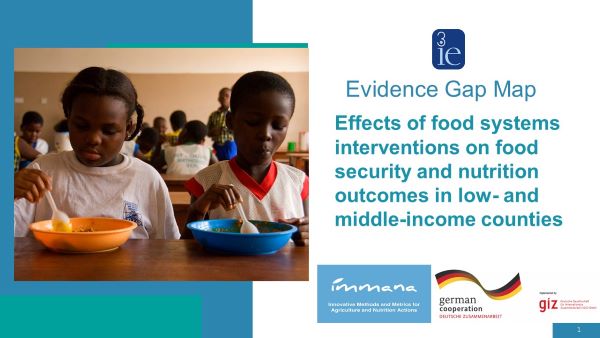·
3ie (2021) The
effects of food systems interventions on food security and nutrition outcomes
in low- and middle- income countries. Policy brief, 8 p.
The International Initiative for Impact Evaluation (3ie) and Innovative Methods and Metrics for Agriculture and Nutrition Actions (IMMANA) research group were commissioned by Deutsche Gesellschaft für Internationale Zusammenarbeit (GIZ) in February 2020 to develop an Evidence Gap Map (EGM) of the effects of food systems interventions on food security and nutrition outcomes. This map can help increase the discoverability of evidence and it’s use by decision makers working on policies and programmes. 1,838 impact evaluations and 178 systematic reviews were identified for this study. In this presentation, we will discuss the main findings of the 3ie food systems evidence gap map, its potential uses, and the implications of this effort for future policy and research. This event is a part of a series of events that 3ie is hosting on nutrition in January 2021.
- Martin Hoppe, Head of division, Food and Nutrition Security, Global Food Policy, Fisheries, BMZ;
- Christoph Langenkamp, Programme Director, Knowledge for Nutrition (K4N);
- Thalia Sparling, Postdoctoral Fellow, Innovative Metrics and Methods for Agriculture and Nutrition Actions (IMMANA);
- Marie Ruel, Director of Poverty, Health, and Nutrition Division, International Food Policy Research Institute (IFPRI);
- Charlotte Lane, Evaluation Specialist, 3ie Chair: Josh Furgeson, Senior Research Fellow, 3ie
"It will really help us in utilizing evidence from food systems interventions to improve nutrition," said Christoph Langenkamp, Programme Director, Knowledge for Nutrition (K4N). "The map will provide a visual and interactive display of this evidence in different sectors and subsectors."
"Technical approaches like nutrient fortification appear to have been evaluated more often than grassroots type approaches. This finding may suggest an inordinate focus on topics that are 'sexy' or 'the current trend'. There is a lot of research, but it's not distributed evenly. There are clearly fields where the (research) coverage on interventions is much more dense than on others." Martin Hoppe, BMZ's Head of division for food and nutrition security, global food policy, and fisheries.
"The map also suggests that researchers do not always study the most appropriate outcome for a given intervention. For example, many food fortification studies were evaluated using anthropometric outcome measures like height or weight, rather than more direct measures of nutrient intake. This [anthropometric measurement] is not the best outcome for a fortification study," Ruel said. "Lots of other things need to fall into place [to see an effect] … it's very possible that a lot of studies [report] negative impacts or don't show impacts because they didn't choose the right outcomes." Marie Ruel, Director of Poverty, Health, and Nutrition Division, International Food Policy Research Institute (IFPRI).
To compound that issue, many studies also do not include any intermediate outcome measures to help show why an intervention did – or did not – work as expected.
"We are not actually learning about how to achieve these outcomes because we are not measuring the causal pathway" 3ie Evaluation Specialist Charlotte Lane.
Several panelists noted their surprise at the relative absence of evaluations linking food systems interventions and gender outcomes. "That was one of the most striking surprises, why is there so little evidence [on women in the food system]?" Langenkamp said.
Several panelists noted their surprise at the relative absence of evaluations linking food systems interventions and gender outcomes. "That was one of the most striking surprises, why is there so little evidence [on women in the food system]?" Langenkamp said.
"Most of the studies that did measure gender outcomes used the same measurement approach, providing a narrow picture, There are a lot of missing other aspects of equity" Thalia Sparling, postdoctoral fellow, Innovative Metrics and Methods for Agriculture and Nutrition Actions (IMMANA).
Also, panelists agreed that the map is most useful when used as a tool to direct further inquiry, and that it cannot provide all the answers on its own.
"The map should not be viewed as a magic genie with the answers, but rather as a roadmap to provide directions. It allows you to step back and see the broader picture, but these maps are never going to be specific enough that they tell you everything you need to know," Thalia Sparling.
The interactive online map can be viewed here, where users can apply filters to search for the topics that interest them. The full report on the map and a brief summary of its findings are here.


No comments:
Post a Comment